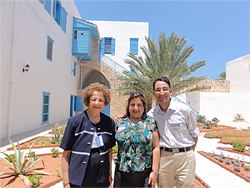June
28, 2011
Our
Bahá’í Pilgrimage to Israel
By Nousha Ram
During the last two weeks of May, my husband and I, along with my
mother-in-law were blessed to have the opportunity to visit Israel on a
pilgrimage to the Bahá’í Shrines and holy sites. There were about 300
other Bahá’í pilgrims during our stay. We met Bahá’ís from Singapore,
Australia, Canada, Macau, Colombia, Malawi, USA, and many other
localities.
Bahá’ís are encouraged to undertake a pilgrimage at least once in their
lifetime. Our pilgrimage spanned ten days and consisted of
guided visits to the Holy Shrines, various other sites in the
Acre/Haifa area associated with the Central Figures of the Bahá’í
Faith, and the Terraces and gardens on Mount Carmel.
Each year thousands of Bahá’í pilgrims from around the world come to
pray and meditate in the Bahá’í Shrines and holy sites. This
region of Israel is sacred because it is where the Faith’s prophet
founder, Bahá’u’lláh, spent his last years and passed away. At
Bahá’u’lláh’s instruction, the spiritual and administrative center of
His Faith is also permanently fixed in the Acre/Haifa area. The Bahá’í
Holy Places in Haifa and Western Galilee are inscribed on the UN World
Heritage list for their historical and spiritual significance, and the
testimony they bear to the strong tradition of pilgrimage in the Bahá’í
faith.
During our pilgrimage we were among a thousand followers of
Bahá’u’lláh, from around the world, who gathered at His burial site on
29 May at 3 a.m. to commemorate the 119th anniversary of His
passing. Around the globe, tens of thousands more turned
their faces in the direction of the same shrine – for Bahá’ís, the
holiest spot on earth – in remembrance of the night in 1892 that
Bahá’u’lláh passed away at His home near Acre.
As part of the commemoration we were able to visit His home, the
Mansion of Bahji, for a few minutes of private prayer in the very room
where He spent His final hours. The room is maintained
exactly as it was during the time of Bahá’u’lláh – even a pair of his
shoes is there for the pilgrims to see. The quadrant of the
gardens at Bahji nearest the Shrine of Bahá’u’lláh is known as the
Haram-i-Aqdas – the most holy sanctuary. We were seated in chairs set
up in the outer ring for a program of prayers and readings, after which
we formed a procession to circumambulate the Shrine.
Bahá’u’lláh was born in Tehran, Iran, but He and a large group of His
followers were banished from their native land in 1853 and forced to go
first to Baghdad, then on to what was the Ottoman Empire and the remote
prison city of Acre. As pilgrims we were able to visit His
prison cell in the old walled city and three houses, including the one
at Bahji, where He eventually was able to stay when authorities eased
the stricter confinement of the prison barracks. His passing in 1892
followed nearly 40 years of exile from His native Iran before His
incarceration in Acre in 1868.
For us, to be on pilgrimage during the anniversary of Bahá’u’lláh's
passing was a time to remember his life of service, reflect on his
suffering, and meditate on his message. Even for many who are not
Bahá’ís, his injunction to humanity to have a "vision that is
world-embracing," is recognized as relevant today as when he passed 119
years ago. Our pilgrimage served not only to inspire us, but also to
bring us together with Bahá’ís from all over the world and give social
cohesion to our Faith. |
|

|